Cadbury: Culture, Power, and Motivation in Organisational Behaviour
VerifiedAdded on 2020/11/23
|13
|3560
|347
Report
AI Summary
This report provides a comprehensive analysis of Cadbury's organisational behaviour, examining how culture, politics, and power influence individual and team performance. It delves into Handy's typology, specifically focusing on how different cultural models, such as power and role cultures, apply to Cadbury and impact decision-making and employee roles. The report also explores the impact of organisational politics, both positive and negative, on employee commitment and job performance. Furthermore, it analyses various types of power, including legitimate, expert, and reward power, and their application within Cadbury. The second part of the report focuses on motivation, discussing both content and process theories. It examines Maslow's hierarchy of needs and Vroom's expectancy theory, illustrating how these theories can be applied to motivate employees and achieve organisational goals. The report concludes by highlighting the most suitable cultural model and power structure for Cadbury, and how motivational techniques can enhance employee performance and overall business objectives.
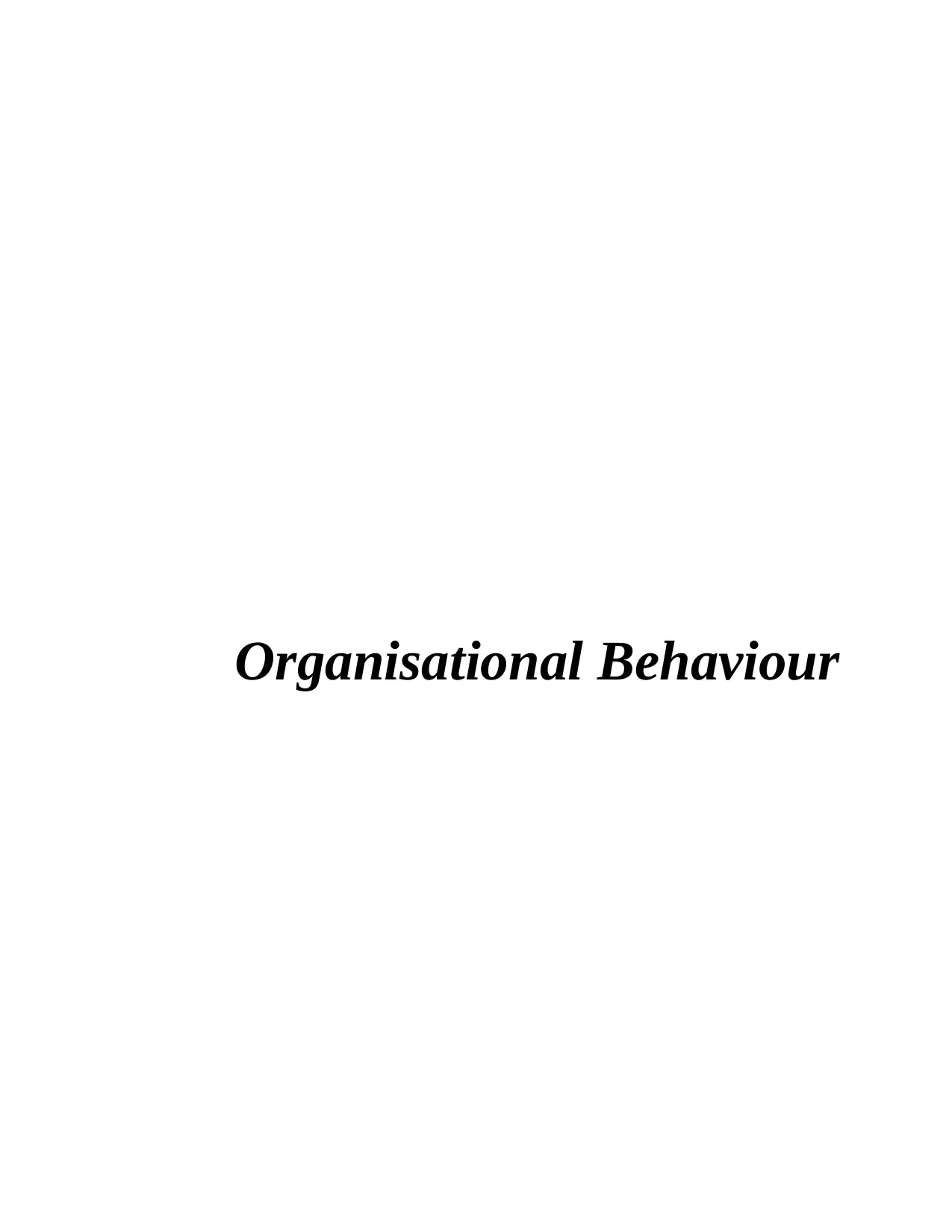
Organisational Behaviour
Paraphrase This Document
Need a fresh take? Get an instant paraphrase of this document with our AI Paraphraser
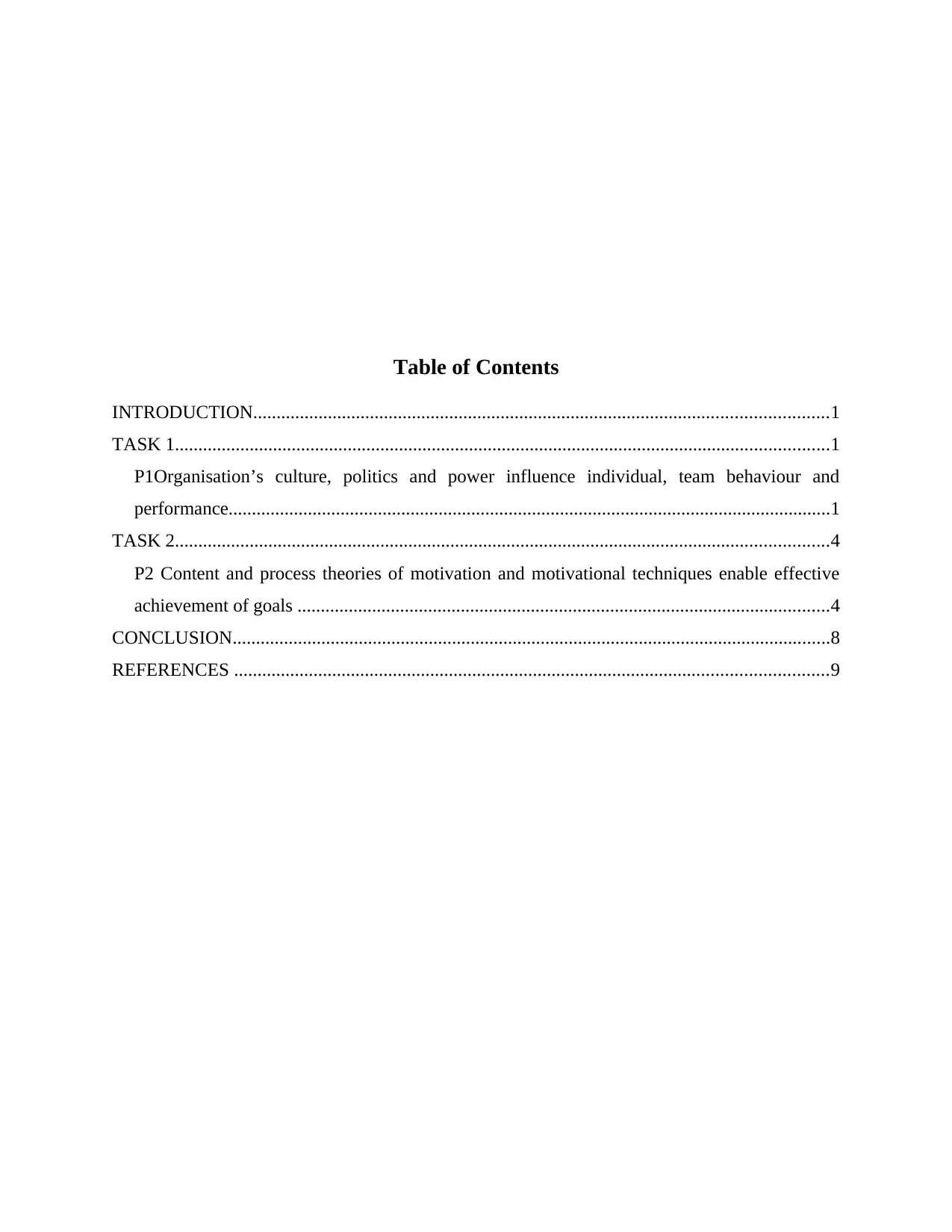
Table of Contents
INTRODUCTION...........................................................................................................................1
TASK 1............................................................................................................................................1
P1Organisation’s culture, politics and power influence individual, team behaviour and
performance.................................................................................................................................1
TASK 2............................................................................................................................................4
P2 Content and process theories of motivation and motivational techniques enable effective
achievement of goals ..................................................................................................................4
CONCLUSION................................................................................................................................8
REFERENCES ...............................................................................................................................9
INTRODUCTION...........................................................................................................................1
TASK 1............................................................................................................................................1
P1Organisation’s culture, politics and power influence individual, team behaviour and
performance.................................................................................................................................1
TASK 2............................................................................................................................................4
P2 Content and process theories of motivation and motivational techniques enable effective
achievement of goals ..................................................................................................................4
CONCLUSION................................................................................................................................8
REFERENCES ...............................................................................................................................9

⊘ This is a preview!⊘
Do you want full access?
Subscribe today to unlock all pages.

Trusted by 1+ million students worldwide
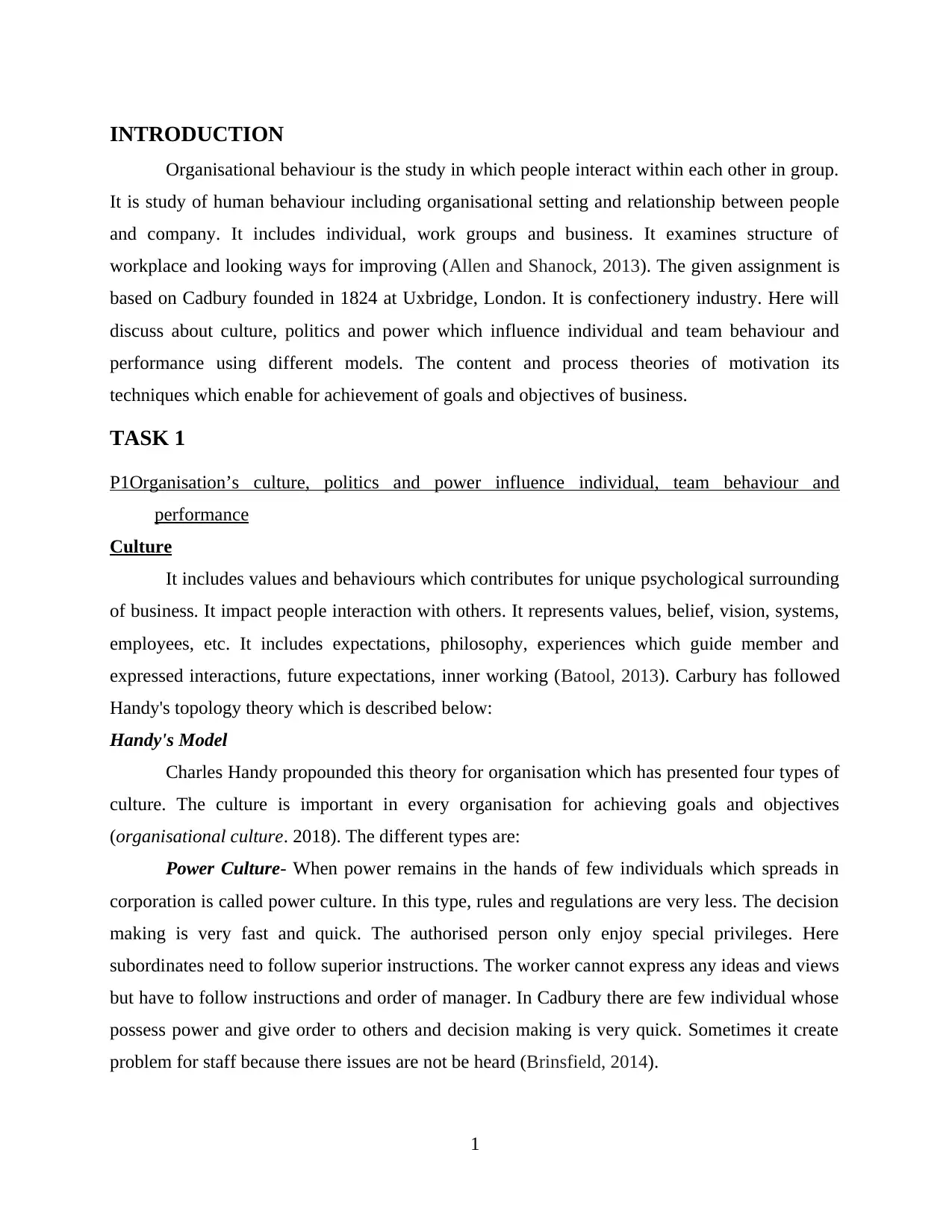
INTRODUCTION
Organisational behaviour is the study in which people interact within each other in group.
It is study of human behaviour including organisational setting and relationship between people
and company. It includes individual, work groups and business. It examines structure of
workplace and looking ways for improving (Allen and Shanock, 2013). The given assignment is
based on Cadbury founded in 1824 at Uxbridge, London. It is confectionery industry. Here will
discuss about culture, politics and power which influence individual and team behaviour and
performance using different models. The content and process theories of motivation its
techniques which enable for achievement of goals and objectives of business.
TASK 1
P1Organisation’s culture, politics and power influence individual, team behaviour and
performance
Culture
It includes values and behaviours which contributes for unique psychological surrounding
of business. It impact people interaction with others. It represents values, belief, vision, systems,
employees, etc. It includes expectations, philosophy, experiences which guide member and
expressed interactions, future expectations, inner working (Batool, 2013). Carbury has followed
Handy's topology theory which is described below:
Handy's Model
Charles Handy propounded this theory for organisation which has presented four types of
culture. The culture is important in every organisation for achieving goals and objectives
(organisational culture. 2018). The different types are:
Power Culture- When power remains in the hands of few individuals which spreads in
corporation is called power culture. In this type, rules and regulations are very less. The decision
making is very fast and quick. The authorised person only enjoy special privileges. Here
subordinates need to follow superior instructions. The worker cannot express any ideas and views
but have to follow instructions and order of manager. In Cadbury there are few individual whose
possess power and give order to others and decision making is very quick. Sometimes it create
problem for staff because there issues are not be heard (Brinsfield, 2014).
1
Organisational behaviour is the study in which people interact within each other in group.
It is study of human behaviour including organisational setting and relationship between people
and company. It includes individual, work groups and business. It examines structure of
workplace and looking ways for improving (Allen and Shanock, 2013). The given assignment is
based on Cadbury founded in 1824 at Uxbridge, London. It is confectionery industry. Here will
discuss about culture, politics and power which influence individual and team behaviour and
performance using different models. The content and process theories of motivation its
techniques which enable for achievement of goals and objectives of business.
TASK 1
P1Organisation’s culture, politics and power influence individual, team behaviour and
performance
Culture
It includes values and behaviours which contributes for unique psychological surrounding
of business. It impact people interaction with others. It represents values, belief, vision, systems,
employees, etc. It includes expectations, philosophy, experiences which guide member and
expressed interactions, future expectations, inner working (Batool, 2013). Carbury has followed
Handy's topology theory which is described below:
Handy's Model
Charles Handy propounded this theory for organisation which has presented four types of
culture. The culture is important in every organisation for achieving goals and objectives
(organisational culture. 2018). The different types are:
Power Culture- When power remains in the hands of few individuals which spreads in
corporation is called power culture. In this type, rules and regulations are very less. The decision
making is very fast and quick. The authorised person only enjoy special privileges. Here
subordinates need to follow superior instructions. The worker cannot express any ideas and views
but have to follow instructions and order of manager. In Cadbury there are few individual whose
possess power and give order to others and decision making is very quick. Sometimes it create
problem for staff because there issues are not be heard (Brinsfield, 2014).
1
Paraphrase This Document
Need a fresh take? Get an instant paraphrase of this document with our AI Paraphraser
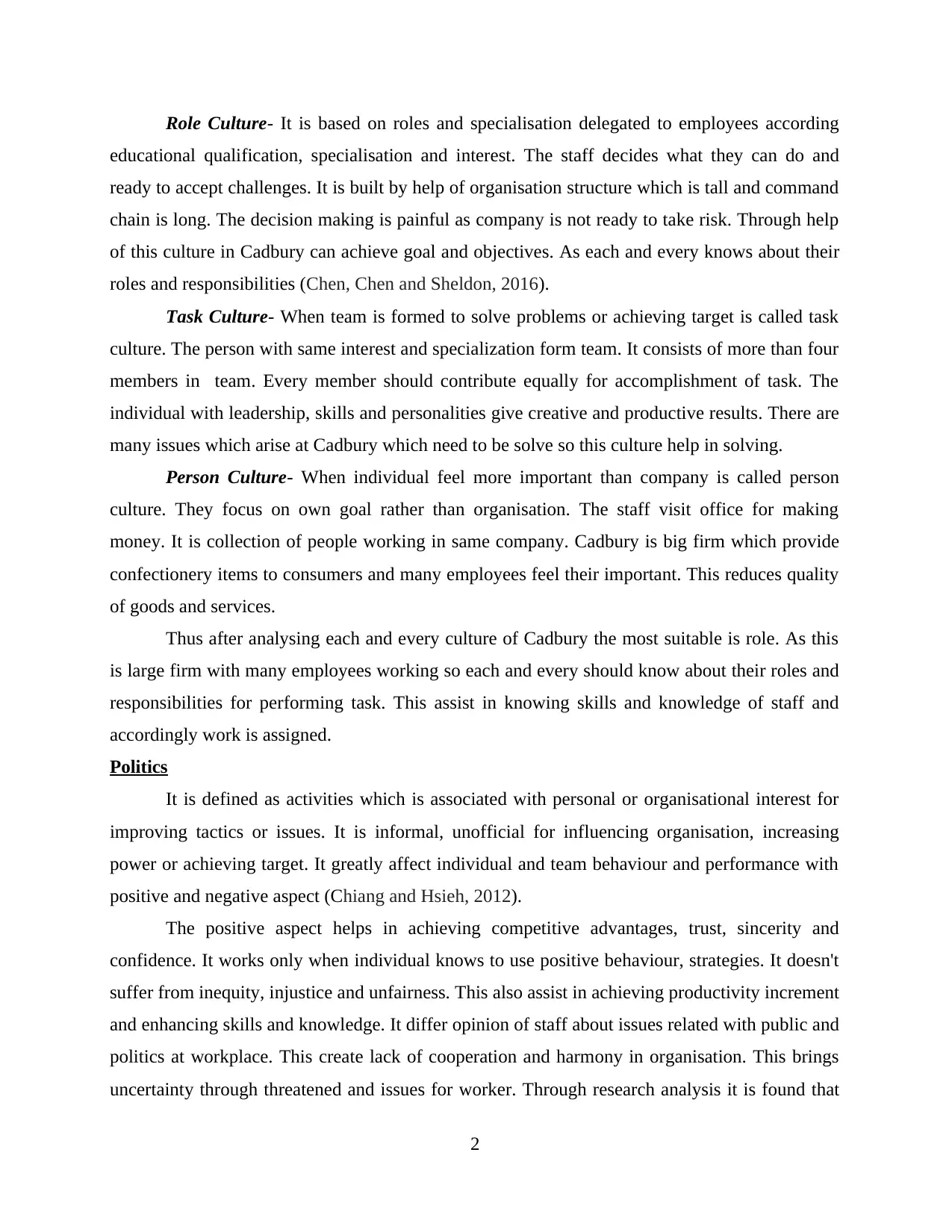
Role Culture- It is based on roles and specialisation delegated to employees according
educational qualification, specialisation and interest. The staff decides what they can do and
ready to accept challenges. It is built by help of organisation structure which is tall and command
chain is long. The decision making is painful as company is not ready to take risk. Through help
of this culture in Cadbury can achieve goal and objectives. As each and every knows about their
roles and responsibilities (Chen, Chen and Sheldon, 2016).
Task Culture- When team is formed to solve problems or achieving target is called task
culture. The person with same interest and specialization form team. It consists of more than four
members in team. Every member should contribute equally for accomplishment of task. The
individual with leadership, skills and personalities give creative and productive results. There are
many issues which arise at Cadbury which need to be solve so this culture help in solving.
Person Culture- When individual feel more important than company is called person
culture. They focus on own goal rather than organisation. The staff visit office for making
money. It is collection of people working in same company. Cadbury is big firm which provide
confectionery items to consumers and many employees feel their important. This reduces quality
of goods and services.
Thus after analysing each and every culture of Cadbury the most suitable is role. As this
is large firm with many employees working so each and every should know about their roles and
responsibilities for performing task. This assist in knowing skills and knowledge of staff and
accordingly work is assigned.
Politics
It is defined as activities which is associated with personal or organisational interest for
improving tactics or issues. It is informal, unofficial for influencing organisation, increasing
power or achieving target. It greatly affect individual and team behaviour and performance with
positive and negative aspect (Chiang and Hsieh, 2012).
The positive aspect helps in achieving competitive advantages, trust, sincerity and
confidence. It works only when individual knows to use positive behaviour, strategies. It doesn't
suffer from inequity, injustice and unfairness. This also assist in achieving productivity increment
and enhancing skills and knowledge. It differ opinion of staff about issues related with public and
politics at workplace. This create lack of cooperation and harmony in organisation. This brings
uncertainty through threatened and issues for worker. Through research analysis it is found that
2
educational qualification, specialisation and interest. The staff decides what they can do and
ready to accept challenges. It is built by help of organisation structure which is tall and command
chain is long. The decision making is painful as company is not ready to take risk. Through help
of this culture in Cadbury can achieve goal and objectives. As each and every knows about their
roles and responsibilities (Chen, Chen and Sheldon, 2016).
Task Culture- When team is formed to solve problems or achieving target is called task
culture. The person with same interest and specialization form team. It consists of more than four
members in team. Every member should contribute equally for accomplishment of task. The
individual with leadership, skills and personalities give creative and productive results. There are
many issues which arise at Cadbury which need to be solve so this culture help in solving.
Person Culture- When individual feel more important than company is called person
culture. They focus on own goal rather than organisation. The staff visit office for making
money. It is collection of people working in same company. Cadbury is big firm which provide
confectionery items to consumers and many employees feel their important. This reduces quality
of goods and services.
Thus after analysing each and every culture of Cadbury the most suitable is role. As this
is large firm with many employees working so each and every should know about their roles and
responsibilities for performing task. This assist in knowing skills and knowledge of staff and
accordingly work is assigned.
Politics
It is defined as activities which is associated with personal or organisational interest for
improving tactics or issues. It is informal, unofficial for influencing organisation, increasing
power or achieving target. It greatly affect individual and team behaviour and performance with
positive and negative aspect (Chiang and Hsieh, 2012).
The positive aspect helps in achieving competitive advantages, trust, sincerity and
confidence. It works only when individual knows to use positive behaviour, strategies. It doesn't
suffer from inequity, injustice and unfairness. This also assist in achieving productivity increment
and enhancing skills and knowledge. It differ opinion of staff about issues related with public and
politics at workplace. This create lack of cooperation and harmony in organisation. This brings
uncertainty through threatened and issues for worker. Through research analysis it is found that
2
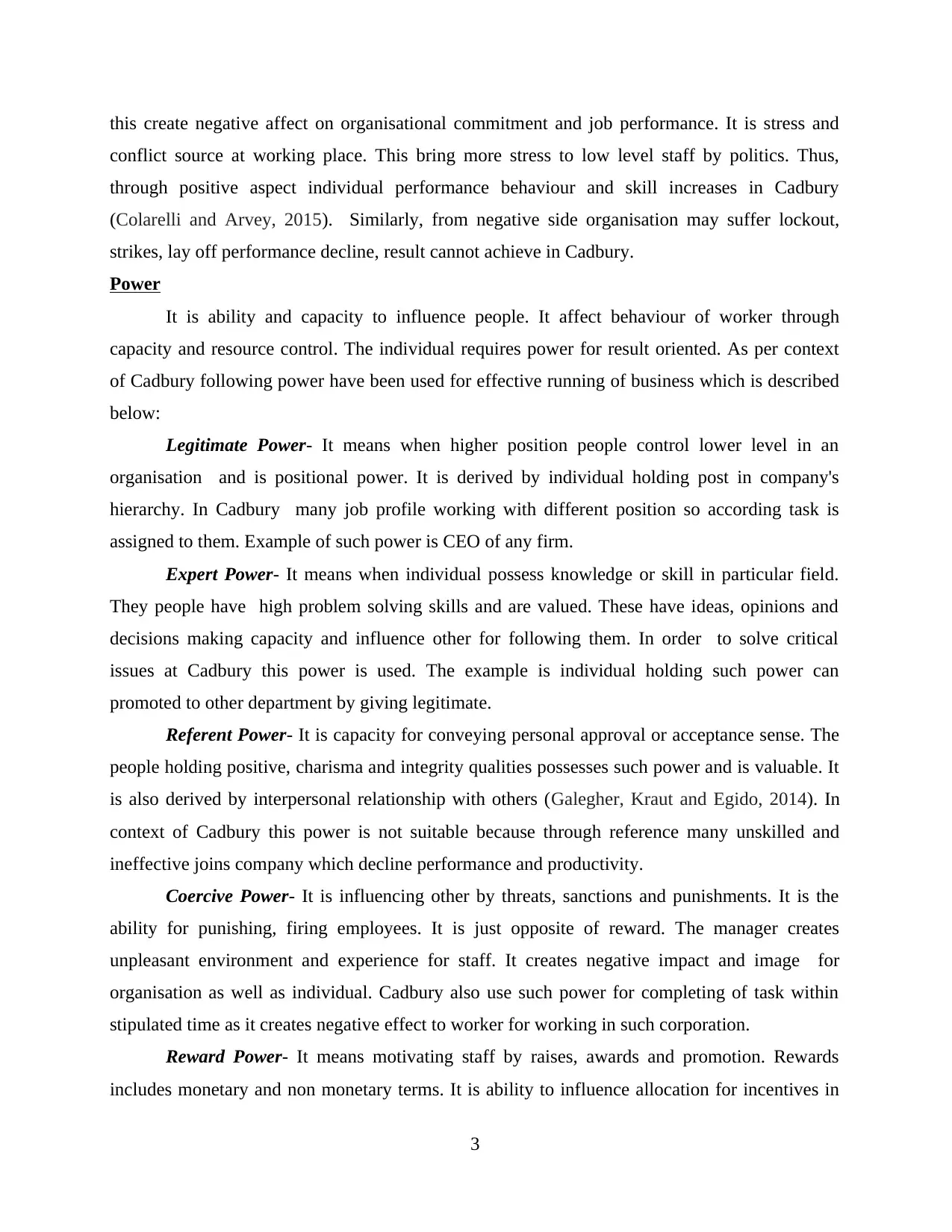
this create negative affect on organisational commitment and job performance. It is stress and
conflict source at working place. This bring more stress to low level staff by politics. Thus,
through positive aspect individual performance behaviour and skill increases in Cadbury
(Colarelli and Arvey, 2015). Similarly, from negative side organisation may suffer lockout,
strikes, lay off performance decline, result cannot achieve in Cadbury.
Power
It is ability and capacity to influence people. It affect behaviour of worker through
capacity and resource control. The individual requires power for result oriented. As per context
of Cadbury following power have been used for effective running of business which is described
below:
Legitimate Power- It means when higher position people control lower level in an
organisation and is positional power. It is derived by individual holding post in company's
hierarchy. In Cadbury many job profile working with different position so according task is
assigned to them. Example of such power is CEO of any firm.
Expert Power- It means when individual possess knowledge or skill in particular field.
They people have high problem solving skills and are valued. These have ideas, opinions and
decisions making capacity and influence other for following them. In order to solve critical
issues at Cadbury this power is used. The example is individual holding such power can
promoted to other department by giving legitimate.
Referent Power- It is capacity for conveying personal approval or acceptance sense. The
people holding positive, charisma and integrity qualities possesses such power and is valuable. It
is also derived by interpersonal relationship with others (Galegher, Kraut and Egido, 2014). In
context of Cadbury this power is not suitable because through reference many unskilled and
ineffective joins company which decline performance and productivity.
Coercive Power- It is influencing other by threats, sanctions and punishments. It is the
ability for punishing, firing employees. It is just opposite of reward. The manager creates
unpleasant environment and experience for staff. It creates negative impact and image for
organisation as well as individual. Cadbury also use such power for completing of task within
stipulated time as it creates negative effect to worker for working in such corporation.
Reward Power- It means motivating staff by raises, awards and promotion. Rewards
includes monetary and non monetary terms. It is ability to influence allocation for incentives in
3
conflict source at working place. This bring more stress to low level staff by politics. Thus,
through positive aspect individual performance behaviour and skill increases in Cadbury
(Colarelli and Arvey, 2015). Similarly, from negative side organisation may suffer lockout,
strikes, lay off performance decline, result cannot achieve in Cadbury.
Power
It is ability and capacity to influence people. It affect behaviour of worker through
capacity and resource control. The individual requires power for result oriented. As per context
of Cadbury following power have been used for effective running of business which is described
below:
Legitimate Power- It means when higher position people control lower level in an
organisation and is positional power. It is derived by individual holding post in company's
hierarchy. In Cadbury many job profile working with different position so according task is
assigned to them. Example of such power is CEO of any firm.
Expert Power- It means when individual possess knowledge or skill in particular field.
They people have high problem solving skills and are valued. These have ideas, opinions and
decisions making capacity and influence other for following them. In order to solve critical
issues at Cadbury this power is used. The example is individual holding such power can
promoted to other department by giving legitimate.
Referent Power- It is capacity for conveying personal approval or acceptance sense. The
people holding positive, charisma and integrity qualities possesses such power and is valuable. It
is also derived by interpersonal relationship with others (Galegher, Kraut and Egido, 2014). In
context of Cadbury this power is not suitable because through reference many unskilled and
ineffective joins company which decline performance and productivity.
Coercive Power- It is influencing other by threats, sanctions and punishments. It is the
ability for punishing, firing employees. It is just opposite of reward. The manager creates
unpleasant environment and experience for staff. It creates negative impact and image for
organisation as well as individual. Cadbury also use such power for completing of task within
stipulated time as it creates negative effect to worker for working in such corporation.
Reward Power- It means motivating staff by raises, awards and promotion. Rewards
includes monetary and non monetary terms. It is ability to influence allocation for incentives in
3
⊘ This is a preview!⊘
Do you want full access?
Subscribe today to unlock all pages.

Trusted by 1+ million students worldwide
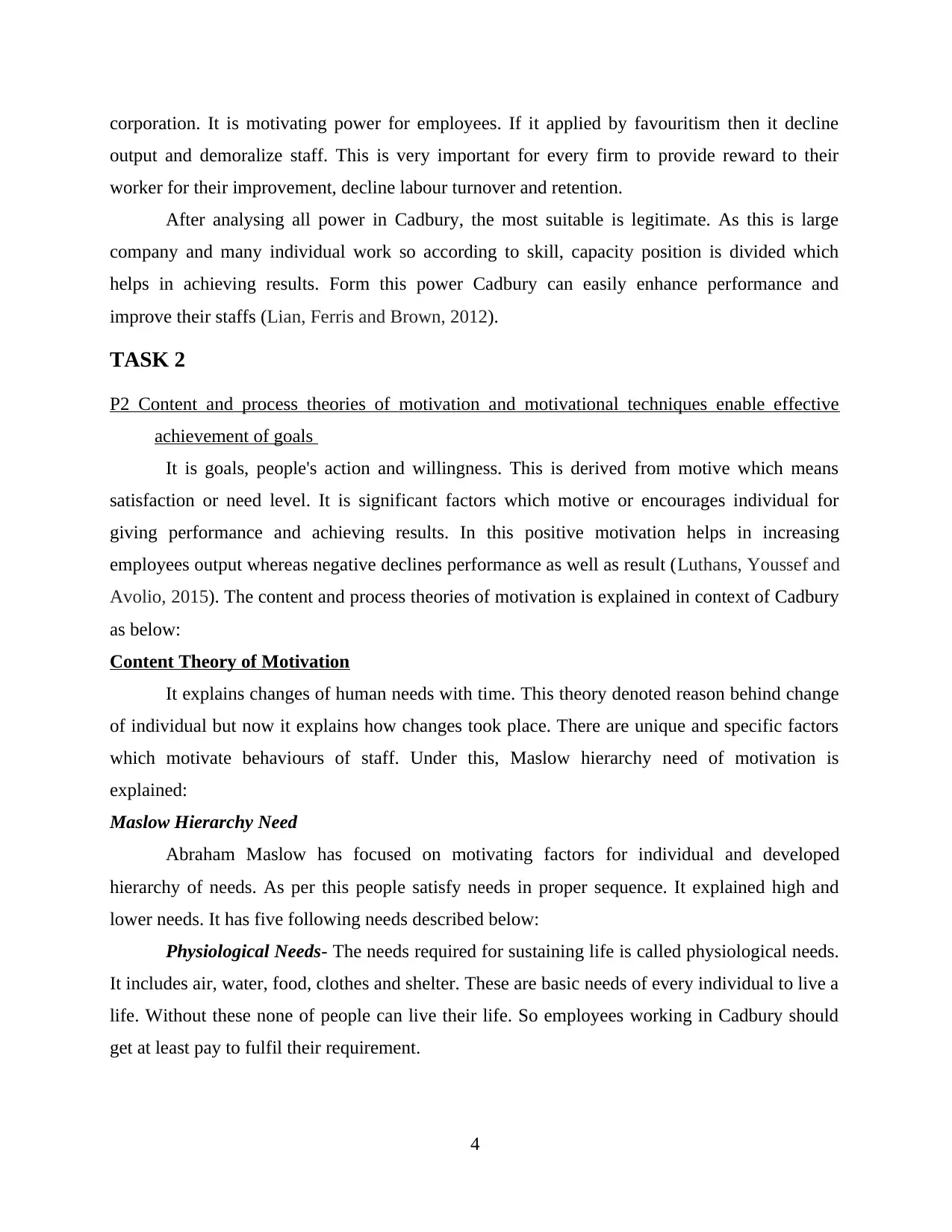
corporation. It is motivating power for employees. If it applied by favouritism then it decline
output and demoralize staff. This is very important for every firm to provide reward to their
worker for their improvement, decline labour turnover and retention.
After analysing all power in Cadbury, the most suitable is legitimate. As this is large
company and many individual work so according to skill, capacity position is divided which
helps in achieving results. Form this power Cadbury can easily enhance performance and
improve their staffs (Lian, Ferris and Brown, 2012).
TASK 2
P2 Content and process theories of motivation and motivational techniques enable effective
achievement of goals
It is goals, people's action and willingness. This is derived from motive which means
satisfaction or need level. It is significant factors which motive or encourages individual for
giving performance and achieving results. In this positive motivation helps in increasing
employees output whereas negative declines performance as well as result (Luthans, Youssef and
Avolio, 2015). The content and process theories of motivation is explained in context of Cadbury
as below:
Content Theory of Motivation
It explains changes of human needs with time. This theory denoted reason behind change
of individual but now it explains how changes took place. There are unique and specific factors
which motivate behaviours of staff. Under this, Maslow hierarchy need of motivation is
explained:
Maslow Hierarchy Need
Abraham Maslow has focused on motivating factors for individual and developed
hierarchy of needs. As per this people satisfy needs in proper sequence. It explained high and
lower needs. It has five following needs described below:
Physiological Needs- The needs required for sustaining life is called physiological needs.
It includes air, water, food, clothes and shelter. These are basic needs of every individual to live a
life. Without these none of people can live their life. So employees working in Cadbury should
get at least pay to fulfil their requirement.
4
output and demoralize staff. This is very important for every firm to provide reward to their
worker for their improvement, decline labour turnover and retention.
After analysing all power in Cadbury, the most suitable is legitimate. As this is large
company and many individual work so according to skill, capacity position is divided which
helps in achieving results. Form this power Cadbury can easily enhance performance and
improve their staffs (Lian, Ferris and Brown, 2012).
TASK 2
P2 Content and process theories of motivation and motivational techniques enable effective
achievement of goals
It is goals, people's action and willingness. This is derived from motive which means
satisfaction or need level. It is significant factors which motive or encourages individual for
giving performance and achieving results. In this positive motivation helps in increasing
employees output whereas negative declines performance as well as result (Luthans, Youssef and
Avolio, 2015). The content and process theories of motivation is explained in context of Cadbury
as below:
Content Theory of Motivation
It explains changes of human needs with time. This theory denoted reason behind change
of individual but now it explains how changes took place. There are unique and specific factors
which motivate behaviours of staff. Under this, Maslow hierarchy need of motivation is
explained:
Maslow Hierarchy Need
Abraham Maslow has focused on motivating factors for individual and developed
hierarchy of needs. As per this people satisfy needs in proper sequence. It explained high and
lower needs. It has five following needs described below:
Physiological Needs- The needs required for sustaining life is called physiological needs.
It includes air, water, food, clothes and shelter. These are basic needs of every individual to live a
life. Without these none of people can live their life. So employees working in Cadbury should
get at least pay to fulfil their requirement.
4
Paraphrase This Document
Need a fresh take? Get an instant paraphrase of this document with our AI Paraphraser
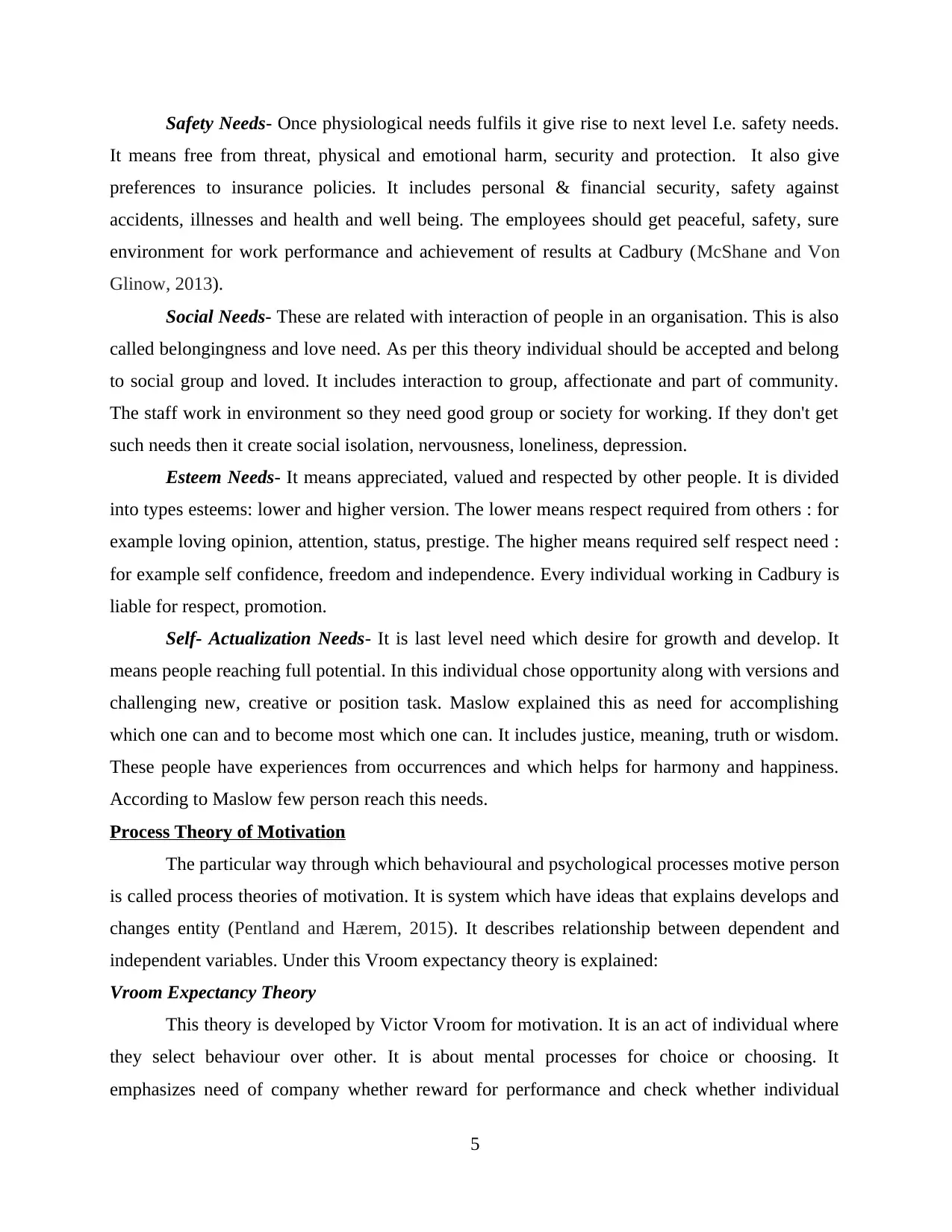
Safety Needs- Once physiological needs fulfils it give rise to next level I.e. safety needs.
It means free from threat, physical and emotional harm, security and protection. It also give
preferences to insurance policies. It includes personal & financial security, safety against
accidents, illnesses and health and well being. The employees should get peaceful, safety, sure
environment for work performance and achievement of results at Cadbury (McShane and Von
Glinow, 2013).
Social Needs- These are related with interaction of people in an organisation. This is also
called belongingness and love need. As per this theory individual should be accepted and belong
to social group and loved. It includes interaction to group, affectionate and part of community.
The staff work in environment so they need good group or society for working. If they don't get
such needs then it create social isolation, nervousness, loneliness, depression.
Esteem Needs- It means appreciated, valued and respected by other people. It is divided
into types esteems: lower and higher version. The lower means respect required from others : for
example loving opinion, attention, status, prestige. The higher means required self respect need :
for example self confidence, freedom and independence. Every individual working in Cadbury is
liable for respect, promotion.
Self- Actualization Needs- It is last level need which desire for growth and develop. It
means people reaching full potential. In this individual chose opportunity along with versions and
challenging new, creative or position task. Maslow explained this as need for accomplishing
which one can and to become most which one can. It includes justice, meaning, truth or wisdom.
These people have experiences from occurrences and which helps for harmony and happiness.
According to Maslow few person reach this needs.
Process Theory of Motivation
The particular way through which behavioural and psychological processes motive person
is called process theories of motivation. It is system which have ideas that explains develops and
changes entity (Pentland and Hærem, 2015). It describes relationship between dependent and
independent variables. Under this Vroom expectancy theory is explained:
Vroom Expectancy Theory
This theory is developed by Victor Vroom for motivation. It is an act of individual where
they select behaviour over other. It is about mental processes for choice or choosing. It
emphasizes need of company whether reward for performance and check whether individual
5
It means free from threat, physical and emotional harm, security and protection. It also give
preferences to insurance policies. It includes personal & financial security, safety against
accidents, illnesses and health and well being. The employees should get peaceful, safety, sure
environment for work performance and achievement of results at Cadbury (McShane and Von
Glinow, 2013).
Social Needs- These are related with interaction of people in an organisation. This is also
called belongingness and love need. As per this theory individual should be accepted and belong
to social group and loved. It includes interaction to group, affectionate and part of community.
The staff work in environment so they need good group or society for working. If they don't get
such needs then it create social isolation, nervousness, loneliness, depression.
Esteem Needs- It means appreciated, valued and respected by other people. It is divided
into types esteems: lower and higher version. The lower means respect required from others : for
example loving opinion, attention, status, prestige. The higher means required self respect need :
for example self confidence, freedom and independence. Every individual working in Cadbury is
liable for respect, promotion.
Self- Actualization Needs- It is last level need which desire for growth and develop. It
means people reaching full potential. In this individual chose opportunity along with versions and
challenging new, creative or position task. Maslow explained this as need for accomplishing
which one can and to become most which one can. It includes justice, meaning, truth or wisdom.
These people have experiences from occurrences and which helps for harmony and happiness.
According to Maslow few person reach this needs.
Process Theory of Motivation
The particular way through which behavioural and psychological processes motive person
is called process theories of motivation. It is system which have ideas that explains develops and
changes entity (Pentland and Hærem, 2015). It describes relationship between dependent and
independent variables. Under this Vroom expectancy theory is explained:
Vroom Expectancy Theory
This theory is developed by Victor Vroom for motivation. It is an act of individual where
they select behaviour over other. It is about mental processes for choice or choosing. It
emphasizes need of company whether reward for performance and check whether individual
5
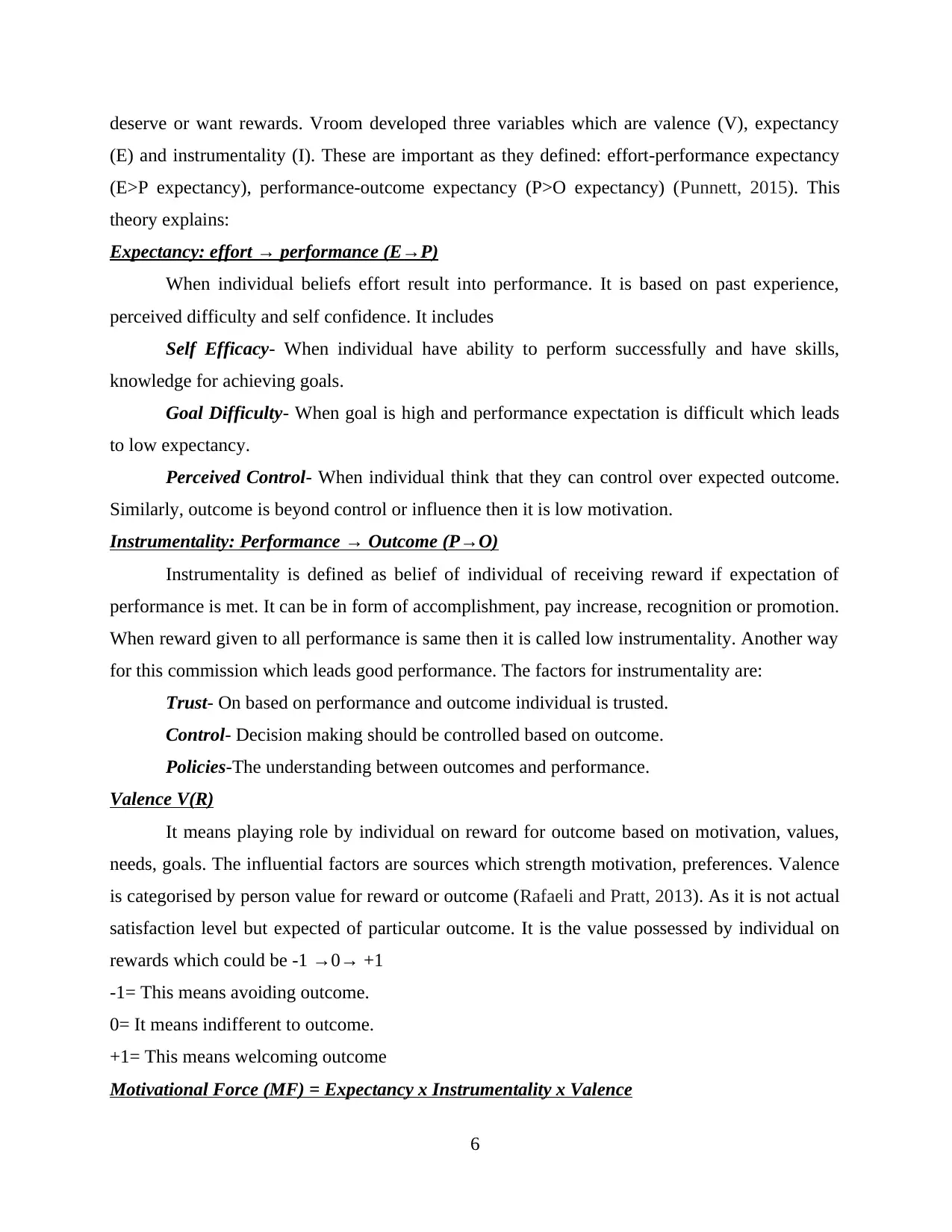
deserve or want rewards. Vroom developed three variables which are valence (V), expectancy
(E) and instrumentality (I). These are important as they defined: effort-performance expectancy
(E>P expectancy), performance-outcome expectancy (P>O expectancy) (Punnett, 2015). This
theory explains:
Expectancy: effort → performance (E→P)
When individual beliefs effort result into performance. It is based on past experience,
perceived difficulty and self confidence. It includes
Self Efficacy- When individual have ability to perform successfully and have skills,
knowledge for achieving goals.
Goal Difficulty- When goal is high and performance expectation is difficult which leads
to low expectancy.
Perceived Control- When individual think that they can control over expected outcome.
Similarly, outcome is beyond control or influence then it is low motivation.
Instrumentality: Performance → Outcome (P→O)
Instrumentality is defined as belief of individual of receiving reward if expectation of
performance is met. It can be in form of accomplishment, pay increase, recognition or promotion.
When reward given to all performance is same then it is called low instrumentality. Another way
for this commission which leads good performance. The factors for instrumentality are:
Trust- On based on performance and outcome individual is trusted.
Control- Decision making should be controlled based on outcome.
Policies-The understanding between outcomes and performance.
Valence V(R)
It means playing role by individual on reward for outcome based on motivation, values,
needs, goals. The influential factors are sources which strength motivation, preferences. Valence
is categorised by person value for reward or outcome (Rafaeli and Pratt, 2013). As it is not actual
satisfaction level but expected of particular outcome. It is the value possessed by individual on
rewards which could be -1 →0→ +1
-1= This means avoiding outcome.
0= It means indifferent to outcome.
+1= This means welcoming outcome
Motivational Force (MF) = Expectancy x Instrumentality x Valence
6
(E) and instrumentality (I). These are important as they defined: effort-performance expectancy
(E>P expectancy), performance-outcome expectancy (P>O expectancy) (Punnett, 2015). This
theory explains:
Expectancy: effort → performance (E→P)
When individual beliefs effort result into performance. It is based on past experience,
perceived difficulty and self confidence. It includes
Self Efficacy- When individual have ability to perform successfully and have skills,
knowledge for achieving goals.
Goal Difficulty- When goal is high and performance expectation is difficult which leads
to low expectancy.
Perceived Control- When individual think that they can control over expected outcome.
Similarly, outcome is beyond control or influence then it is low motivation.
Instrumentality: Performance → Outcome (P→O)
Instrumentality is defined as belief of individual of receiving reward if expectation of
performance is met. It can be in form of accomplishment, pay increase, recognition or promotion.
When reward given to all performance is same then it is called low instrumentality. Another way
for this commission which leads good performance. The factors for instrumentality are:
Trust- On based on performance and outcome individual is trusted.
Control- Decision making should be controlled based on outcome.
Policies-The understanding between outcomes and performance.
Valence V(R)
It means playing role by individual on reward for outcome based on motivation, values,
needs, goals. The influential factors are sources which strength motivation, preferences. Valence
is categorised by person value for reward or outcome (Rafaeli and Pratt, 2013). As it is not actual
satisfaction level but expected of particular outcome. It is the value possessed by individual on
rewards which could be -1 →0→ +1
-1= This means avoiding outcome.
0= It means indifferent to outcome.
+1= This means welcoming outcome
Motivational Force (MF) = Expectancy x Instrumentality x Valence
6
⊘ This is a preview!⊘
Do you want full access?
Subscribe today to unlock all pages.

Trusted by 1+ million students worldwide
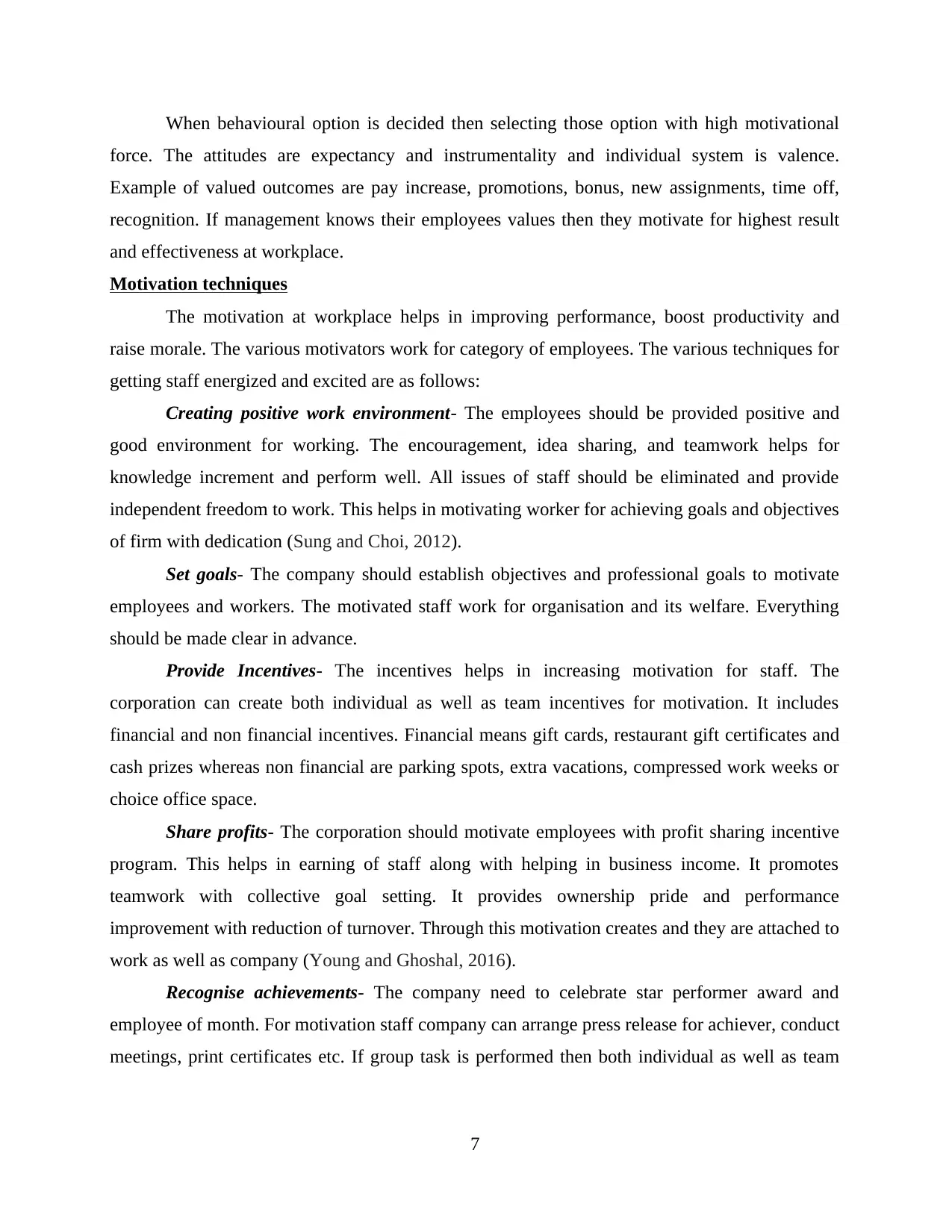
When behavioural option is decided then selecting those option with high motivational
force. The attitudes are expectancy and instrumentality and individual system is valence.
Example of valued outcomes are pay increase, promotions, bonus, new assignments, time off,
recognition. If management knows their employees values then they motivate for highest result
and effectiveness at workplace.
Motivation techniques
The motivation at workplace helps in improving performance, boost productivity and
raise morale. The various motivators work for category of employees. The various techniques for
getting staff energized and excited are as follows:
Creating positive work environment- The employees should be provided positive and
good environment for working. The encouragement, idea sharing, and teamwork helps for
knowledge increment and perform well. All issues of staff should be eliminated and provide
independent freedom to work. This helps in motivating worker for achieving goals and objectives
of firm with dedication (Sung and Choi, 2012).
Set goals- The company should establish objectives and professional goals to motivate
employees and workers. The motivated staff work for organisation and its welfare. Everything
should be made clear in advance.
Provide Incentives- The incentives helps in increasing motivation for staff. The
corporation can create both individual as well as team incentives for motivation. It includes
financial and non financial incentives. Financial means gift cards, restaurant gift certificates and
cash prizes whereas non financial are parking spots, extra vacations, compressed work weeks or
choice office space.
Share profits- The corporation should motivate employees with profit sharing incentive
program. This helps in earning of staff along with helping in business income. It promotes
teamwork with collective goal setting. It provides ownership pride and performance
improvement with reduction of turnover. Through this motivation creates and they are attached to
work as well as company (Young and Ghoshal, 2016).
Recognise achievements- The company need to celebrate star performer award and
employee of month. For motivation staff company can arrange press release for achiever, conduct
meetings, print certificates etc. If group task is performed then both individual as well as team
7
force. The attitudes are expectancy and instrumentality and individual system is valence.
Example of valued outcomes are pay increase, promotions, bonus, new assignments, time off,
recognition. If management knows their employees values then they motivate for highest result
and effectiveness at workplace.
Motivation techniques
The motivation at workplace helps in improving performance, boost productivity and
raise morale. The various motivators work for category of employees. The various techniques for
getting staff energized and excited are as follows:
Creating positive work environment- The employees should be provided positive and
good environment for working. The encouragement, idea sharing, and teamwork helps for
knowledge increment and perform well. All issues of staff should be eliminated and provide
independent freedom to work. This helps in motivating worker for achieving goals and objectives
of firm with dedication (Sung and Choi, 2012).
Set goals- The company should establish objectives and professional goals to motivate
employees and workers. The motivated staff work for organisation and its welfare. Everything
should be made clear in advance.
Provide Incentives- The incentives helps in increasing motivation for staff. The
corporation can create both individual as well as team incentives for motivation. It includes
financial and non financial incentives. Financial means gift cards, restaurant gift certificates and
cash prizes whereas non financial are parking spots, extra vacations, compressed work weeks or
choice office space.
Share profits- The corporation should motivate employees with profit sharing incentive
program. This helps in earning of staff along with helping in business income. It promotes
teamwork with collective goal setting. It provides ownership pride and performance
improvement with reduction of turnover. Through this motivation creates and they are attached to
work as well as company (Young and Ghoshal, 2016).
Recognise achievements- The company need to celebrate star performer award and
employee of month. For motivation staff company can arrange press release for achiever, conduct
meetings, print certificates etc. If group task is performed then both individual as well as team
7
Paraphrase This Document
Need a fresh take? Get an instant paraphrase of this document with our AI Paraphraser
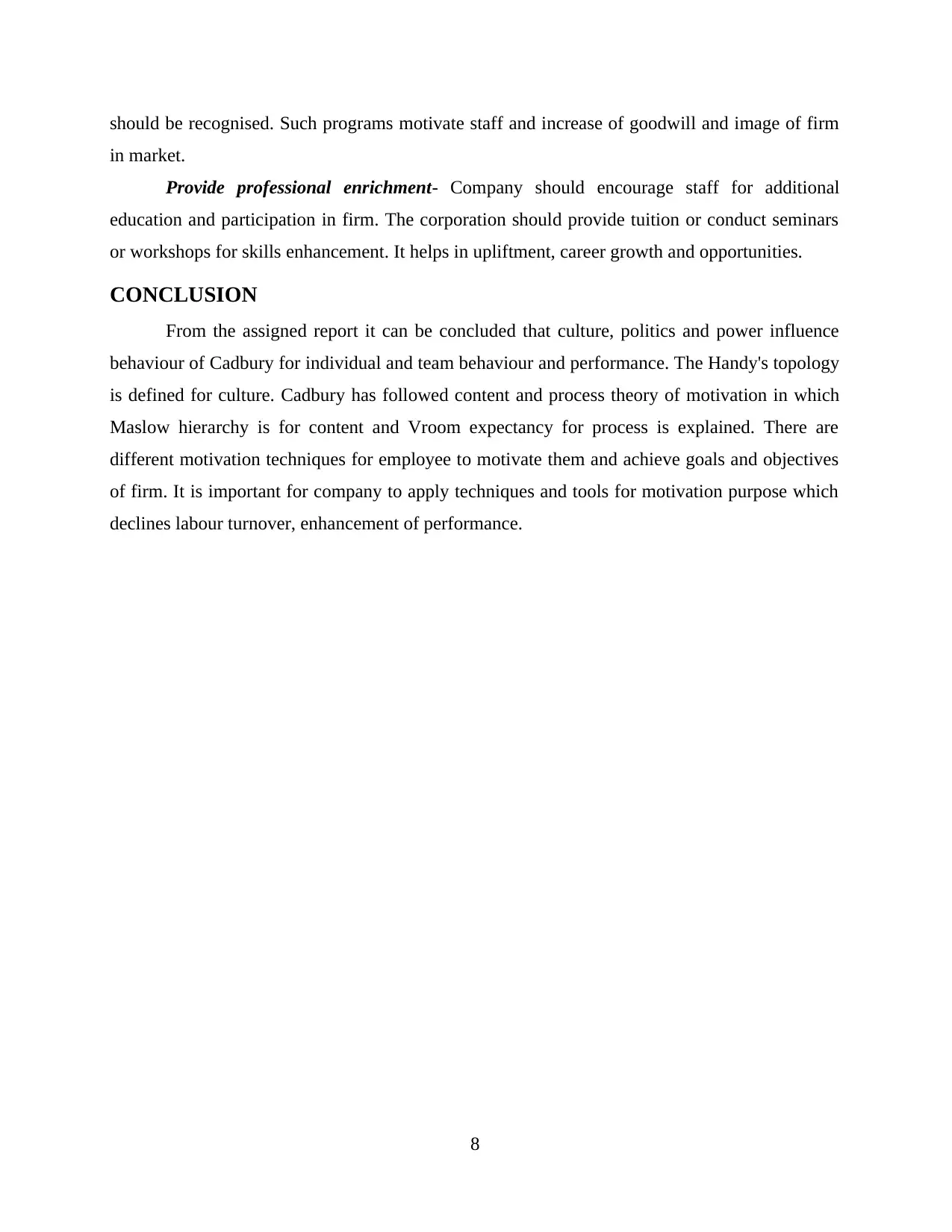
should be recognised. Such programs motivate staff and increase of goodwill and image of firm
in market.
Provide professional enrichment- Company should encourage staff for additional
education and participation in firm. The corporation should provide tuition or conduct seminars
or workshops for skills enhancement. It helps in upliftment, career growth and opportunities.
CONCLUSION
From the assigned report it can be concluded that culture, politics and power influence
behaviour of Cadbury for individual and team behaviour and performance. The Handy's topology
is defined for culture. Cadbury has followed content and process theory of motivation in which
Maslow hierarchy is for content and Vroom expectancy for process is explained. There are
different motivation techniques for employee to motivate them and achieve goals and objectives
of firm. It is important for company to apply techniques and tools for motivation purpose which
declines labour turnover, enhancement of performance.
8
in market.
Provide professional enrichment- Company should encourage staff for additional
education and participation in firm. The corporation should provide tuition or conduct seminars
or workshops for skills enhancement. It helps in upliftment, career growth and opportunities.
CONCLUSION
From the assigned report it can be concluded that culture, politics and power influence
behaviour of Cadbury for individual and team behaviour and performance. The Handy's topology
is defined for culture. Cadbury has followed content and process theory of motivation in which
Maslow hierarchy is for content and Vroom expectancy for process is explained. There are
different motivation techniques for employee to motivate them and achieve goals and objectives
of firm. It is important for company to apply techniques and tools for motivation purpose which
declines labour turnover, enhancement of performance.
8
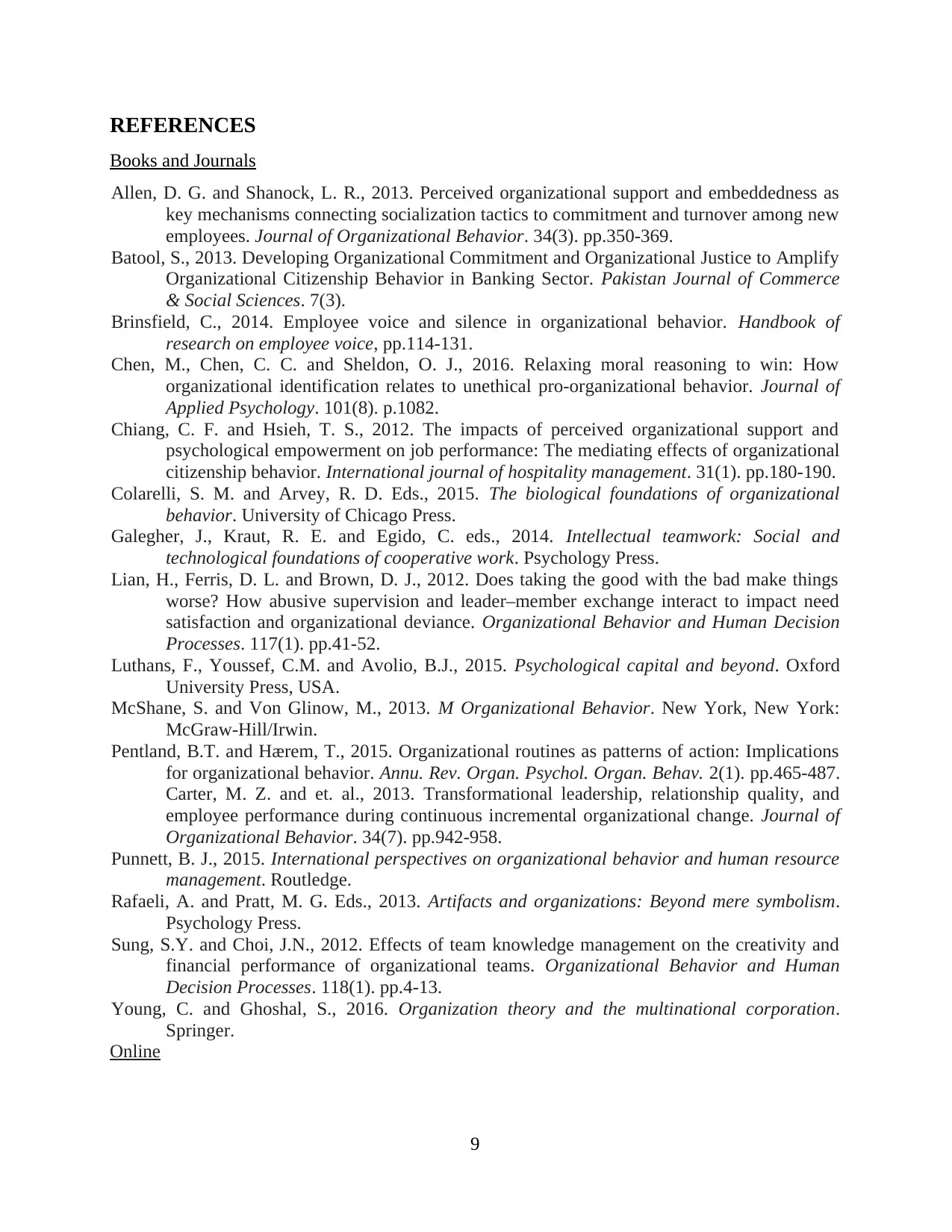
REFERENCES
Books and Journals
Allen, D. G. and Shanock, L. R., 2013. Perceived organizational support and embeddedness as
key mechanisms connecting socialization tactics to commitment and turnover among new
employees. Journal of Organizational Behavior. 34(3). pp.350-369.
Batool, S., 2013. Developing Organizational Commitment and Organizational Justice to Amplify
Organizational Citizenship Behavior in Banking Sector. Pakistan Journal of Commerce
& Social Sciences. 7(3).
Brinsfield, C., 2014. Employee voice and silence in organizational behavior. Handbook of
research on employee voice, pp.114-131.
Chen, M., Chen, C. C. and Sheldon, O. J., 2016. Relaxing moral reasoning to win: How
organizational identification relates to unethical pro-organizational behavior. Journal of
Applied Psychology. 101(8). p.1082.
Chiang, C. F. and Hsieh, T. S., 2012. The impacts of perceived organizational support and
psychological empowerment on job performance: The mediating effects of organizational
citizenship behavior. International journal of hospitality management. 31(1). pp.180-190.
Colarelli, S. M. and Arvey, R. D. Eds., 2015. The biological foundations of organizational
behavior. University of Chicago Press.
Galegher, J., Kraut, R. E. and Egido, C. eds., 2014. Intellectual teamwork: Social and
technological foundations of cooperative work. Psychology Press.
Lian, H., Ferris, D. L. and Brown, D. J., 2012. Does taking the good with the bad make things
worse? How abusive supervision and leader–member exchange interact to impact need
satisfaction and organizational deviance. Organizational Behavior and Human Decision
Processes. 117(1). pp.41-52.
Luthans, F., Youssef, C.M. and Avolio, B.J., 2015. Psychological capital and beyond. Oxford
University Press, USA.
McShane, S. and Von Glinow, M., 2013. M Organizational Behavior. New York, New York:
McGraw-Hill/Irwin.
Pentland, B.T. and Hærem, T., 2015. Organizational routines as patterns of action: Implications
for organizational behavior. Annu. Rev. Organ. Psychol. Organ. Behav. 2(1). pp.465-487.
Carter, M. Z. and et. al., 2013. Transformational leadership, relationship quality, and
employee performance during continuous incremental organizational change. Journal of
Organizational Behavior. 34(7). pp.942-958.
Punnett, B. J., 2015. International perspectives on organizational behavior and human resource
management. Routledge.
Rafaeli, A. and Pratt, M. G. Eds., 2013. Artifacts and organizations: Beyond mere symbolism.
Psychology Press.
Sung, S.Y. and Choi, J.N., 2012. Effects of team knowledge management on the creativity and
financial performance of organizational teams. Organizational Behavior and Human
Decision Processes. 118(1). pp.4-13.
Young, C. and Ghoshal, S., 2016. Organization theory and the multinational corporation.
Springer.
Online
9
Books and Journals
Allen, D. G. and Shanock, L. R., 2013. Perceived organizational support and embeddedness as
key mechanisms connecting socialization tactics to commitment and turnover among new
employees. Journal of Organizational Behavior. 34(3). pp.350-369.
Batool, S., 2013. Developing Organizational Commitment and Organizational Justice to Amplify
Organizational Citizenship Behavior in Banking Sector. Pakistan Journal of Commerce
& Social Sciences. 7(3).
Brinsfield, C., 2014. Employee voice and silence in organizational behavior. Handbook of
research on employee voice, pp.114-131.
Chen, M., Chen, C. C. and Sheldon, O. J., 2016. Relaxing moral reasoning to win: How
organizational identification relates to unethical pro-organizational behavior. Journal of
Applied Psychology. 101(8). p.1082.
Chiang, C. F. and Hsieh, T. S., 2012. The impacts of perceived organizational support and
psychological empowerment on job performance: The mediating effects of organizational
citizenship behavior. International journal of hospitality management. 31(1). pp.180-190.
Colarelli, S. M. and Arvey, R. D. Eds., 2015. The biological foundations of organizational
behavior. University of Chicago Press.
Galegher, J., Kraut, R. E. and Egido, C. eds., 2014. Intellectual teamwork: Social and
technological foundations of cooperative work. Psychology Press.
Lian, H., Ferris, D. L. and Brown, D. J., 2012. Does taking the good with the bad make things
worse? How abusive supervision and leader–member exchange interact to impact need
satisfaction and organizational deviance. Organizational Behavior and Human Decision
Processes. 117(1). pp.41-52.
Luthans, F., Youssef, C.M. and Avolio, B.J., 2015. Psychological capital and beyond. Oxford
University Press, USA.
McShane, S. and Von Glinow, M., 2013. M Organizational Behavior. New York, New York:
McGraw-Hill/Irwin.
Pentland, B.T. and Hærem, T., 2015. Organizational routines as patterns of action: Implications
for organizational behavior. Annu. Rev. Organ. Psychol. Organ. Behav. 2(1). pp.465-487.
Carter, M. Z. and et. al., 2013. Transformational leadership, relationship quality, and
employee performance during continuous incremental organizational change. Journal of
Organizational Behavior. 34(7). pp.942-958.
Punnett, B. J., 2015. International perspectives on organizational behavior and human resource
management. Routledge.
Rafaeli, A. and Pratt, M. G. Eds., 2013. Artifacts and organizations: Beyond mere symbolism.
Psychology Press.
Sung, S.Y. and Choi, J.N., 2012. Effects of team knowledge management on the creativity and
financial performance of organizational teams. Organizational Behavior and Human
Decision Processes. 118(1). pp.4-13.
Young, C. and Ghoshal, S., 2016. Organization theory and the multinational corporation.
Springer.
Online
9
⊘ This is a preview!⊘
Do you want full access?
Subscribe today to unlock all pages.

Trusted by 1+ million students worldwide
1 out of 13
Related Documents
Your All-in-One AI-Powered Toolkit for Academic Success.
+13062052269
info@desklib.com
Available 24*7 on WhatsApp / Email
![[object Object]](/_next/static/media/star-bottom.7253800d.svg)
Unlock your academic potential
Copyright © 2020–2025 A2Z Services. All Rights Reserved. Developed and managed by ZUCOL.




